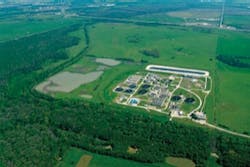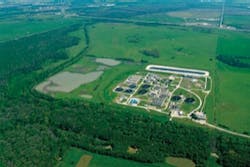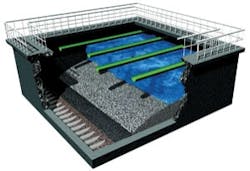World's largest backwash water reuse installation uses Berson UV disinfection technology
• 1.25 million m³/year of water is now recycled as drinking water at Dutch groundwater facility
Berson supplied two InLine 250+ medium pressure UV systems, each disinfecting up to 100m³/hour of backwash water. They are positioned after the ultra filtration units and before the sand filtration. The UV systems produce a 2 log reduction of CFUs* with a water transmittance (T10**) value of 63.1%.
Operated by Vitens, the Netherlands' largest water utility, the facility 35 kilometers south of Leeuwarden in the north of Holland is the largest groundwater drinking water facility in the Netherlands and is also believed to be the largest backwash installation in the world. The contractor for the backwash project was Logisticon Water Treatment b.v.
The Spannenburg drinking water plant supplies over 300,000 people spread over a large, mainly rural area of northern Holland. Because the installation has been so successful Berson has now also been awarded the contract for an identical application in Zwolle, also operated by Vitens.
An important feature of the Berson UV technology installed at Spannenburg is its UV-Tronic+ V5 PLC controller, the latest version of Berson's UV-Tronic controller range. Based on a rugged industrial PLC and with an RS485-based ModBus interface, the UV-Tronic+ V5 links to the site's SCADA control system and allows users to set up and manage the UV system's operating parameters to exactly match their requirements.
Berson UV is one of the few non-German UV system suppliers capable of providing a complete range of UV systems with capacities between 10 -- 10,000 m³/hour, certified to the newest German DVGW*** norm, W294, Part 1, 2 & 3 -- the highest standard currently possible in the world.
* Colony Forming Units** A simple indication of the absorbance of UV light by water is the transmission value of the water (T10), which is the total value of all absorbing components in the water, such as suspended organic materials and minerals such as iron and magnesium -- both dissolved and un-dissolved. If the transmission value is known, the calculation of UV intensity in the UV reactor can be calculated and the size of the reactor determined. Depending on the size or volume of the reactor, the UV dose can then be calculated
*** DVGW (German Technical and Scientific Association for Gas and Water) is the body responsible for industry self-regulation in the German water and gas and water supply industry and its technical rules are the basis for safety and reliability
###


